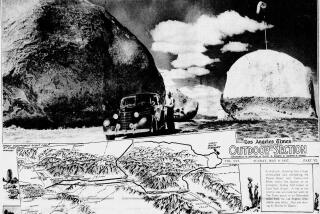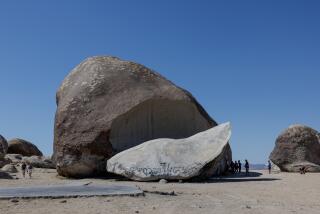Cracks Showing in Venerable Plymouth Rock Legend
- Share via
PLYMOUTH, Mass. — An ancient, icy Atlantic wind churns Plymouth Harbor, the sky spreads a slate gloom, and some teenagers stare solemnly at a boulder caged in a sand pit, like a circus act.
The year “1620” is carved in its flank. A fat seam of mortar fills a diagonal crack. A marker for modern pilgrims identifies this pale, plump chunk of granite--just six feet across--as Plymouth Rock.
“Tradition tells us that the Pilgrims stepped upon this rock when they arrived in Plymouth in December of 1620,” drones the sign at Pilgrim Memorial State Park.
But Matt Souza of nearby Lakeville, a teenager with a baseball cap and pierced ear, heard it differently.
“I heard it came from a quarry in Quincy. My dad supposedly knows the guy that moved it. That’s how it got cracked,” he says, seemingly in earnest.
The sign’s version may be only slightly less cracked.
Most historians have concluded that the widely accepted story of the rock is likely a crock, a rousing myth first fanned by Revolutionary War passions and later by New England’s regional superiority complex. Scholar John Seelye, who wrote the 1998 study “Memory’s Nation: The Place of Plymouth Rock,” says it stands at the center of “what amounts to an ongoing hoax.”
Blarney or not, this stone and its story hold a lode of truth about conflicts in the national character: strong ideals and fast deals, faith and pragmatism, gullibility and guile. In the world after Sept. 11, when patriotic symbols gleam with new luster, Plymouth Rock is a place worth revisiting.
We all know the story: In the winter of 1620, the bedraggled Pilgrims from the Mayflower, rebuffing the Church of England, spilled from their scouting boat onto Plymouth Rock--a sort of welcome-to-America mat. They stopped there and struck noble or prayerful poses for the benefit of unborn illustrators. Then they set out to father a country.
The truth? Well, to start with, both Pilgrims and Rock were there. Geologists believe the boulder was deposited by a glacier about 30,000 years ago. The Pilgrims built their first homes just up the hill from the rock. But William Bradford, their chief chronicler, later wrote that they simply “marched into ye land.”
Not a word survives about ye rock until nearly a century later. In 1715, a town surveying record takes note of this boulder, the hulk of the beach. But it mentions it simply as a rock--not “the” rock.
Born in local oral tradition, the story of the rock only catches on more broadly decades later, as the colonists contemplate a split from England. They start to build their new identity on a rock.
“It was kind of a ready-made symbol,” says Robert Arner, a University of Cincinnati professor who has written about colonial America. “It never was about a stone as stone. Otherwise, they would have blown it out of the way to make room for a wharf.”
In fact, there was a plan for a wharf around 1741. Fearing that a certain boulder would be buried underneath, Thomas Faunce, a 95-year-old church elder who had been town clerk, wanted to be carried down to the beach on a chair for one last look.
The tearful old man told how his father, who arrived in Plymouth three years after the Mayflower, had spoken of this rock as the place where the forefathers first stepped onto the new homeland. His father wanted it “perpetuated to posterity,” he said.
The locals were moved, and the rock wasn’t. (Years later, a dock was finally erected--but around the rock.)
As early as the 1770s, there are a few surviving references to the legend of the rock, including a news story and a map with a note written by a Pilgrim’s great-great grandson. But it is largely thanks to Faunce--or the story of his day at the beach--that the hulk became known as Forefathers’ Rock and, later, Plymouth Rock.
The problem is, the Faunce story survives mainly through James Thacher’s 1832 “History of Plymouth.” Thacher had been a surgeon with a colonial detachment in the Revolution, more than 150 years after the landing. But he says he heard the Faunce story from church deacon Ephraim Spooner.
“It’s almost comical anyone would have believed it,” says Richard Shenkman, who writes about historical fictions and edits an online history magazine at George Mason University.
No matter. By 1774, townsfolk, swept up in anti-English fury, decided the rock deserved better treatment, as Thacher tells it. With the help of about 60 oxen, they set out to lug the rock to a place of honor in Town Square beside a liberty pole, a hub for revolutionary activity.
They jacked it up, tried to heave it into a carriage, and--oopsies!--the darn thing cracked in two. Oh well, maybe it was a good omen for a breakaway war. Besides, it was now a whole lot easier to drag up the hill. The base was left on the beach.
With the legend spreading, souvenir hunters started chipping off pieces from both the top and bottom parts of the estranged rock. “Its very dust is shared as a relic,” wrote Frenchman Alexis de Tocqueville in 1835.
Nature writer Henry David Thoreau was offered a memento but declined. Others delighted in the offer. The rock turned into paperweights, cornerstones, at least one door step, filling for a concrete floor, family heirlooms. Finally, guards were posted.
“You’ve got thrifty Yankees. If you got some damn fool tourist who wants to give you $1.50 for it, you take it,” says Peggy Baker, director of Plymouth’s Pilgrim Hall Museum. The museum displays its own slab.
The top part of the rock was finally enclosed in an iron fence and eventually reunited with the boulder’s bottom at the shore beneath a granite canopy. For the 300th anniversary of the landing, the National Society of Colonial Dames of America erected a Parthenon-style portico over the rock.
In the last several decades, its legend has been increasingly eclipsed by the story--also a mixture of fact and fancy--of the Thanksgiving feast between the Pilgrims and their Wampanoag neighbors.
“Now where does the rock come in? It doesn’t,” says Mayflower descendant Jim Baker, a Plymouth historian and husband of the museum director. (Actually, American Indians have poured paint or dumped sand on it during Thanksgiving protests starting in the 1960s, after which it was cleaned up.)
What remains of the rock is estimated to weigh about six tons. High tides still slosh over it, exposing it to more natural damage on top of centuries of a nation’s hard love.
But the rock is still tended like a beloved, if out-of-step, great-grandparent. It is periodically waterproofed, its cracks mortared.
It’s still a buttress for local tourism in what is promoted as America’s hometown. (Never mind that English people settled 13 years earlier down in Jamestown, in the Virginia colony.)
You can visit the rock for free at any hour, even if more profitable attractions await just down Water Street, like whale watching and a reenacted pirate adventure. If you really do like history, the role-playing characters at Plimouth Plantation (which uses the old spelling) will interact with you.
The rock says and does nothing, yet an estimated 800,000 people a year still come from the far ends of this super-sized nation, and beyond, to take a look.
Many are disappointed. “I should have known it was just a rock,” griped college administrator Peter Dolce, a visitor from Nashville.
Yet, many return again and again, even in the kind of weather that killed dozens of Pilgrims the first winter. “It’s just something you always do; you just come here,” said Evan Mazetis, another in the group of teenagers stopping by the beach in winter.
The Pilgrims chose this spot for its protected harbor and flat, safe shoreline. Given a choice, they would probably have avoided Plymouth Rock as a hazard to their wooden boats, Seelye suggests.
But the legend and its followers endure. Ruth B. Walker, 83, a Plymouth native who acts as a state-park interpreter of the rock, says the Pilgrims probably stepped on it to keep their feet dry in that cold, wet winter.
“It would have made good sense,” she says. That’s argument enough for many New Englanders--and many other Americans.
More to Read
Sign up for The Wild
We’ll help you find the best places to hike, bike and run, as well as the perfect silent spots for meditation and yoga.
You may occasionally receive promotional content from the Los Angeles Times.






